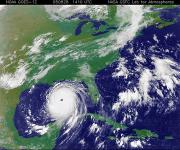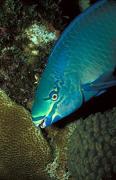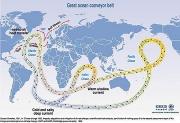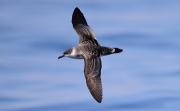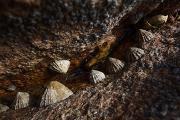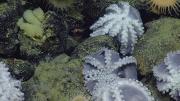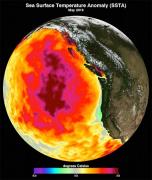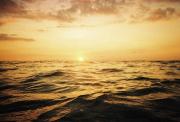Radio Program
Our regular Science and the SeaTM radio program presents marine science topics in an engaging two-minute story format. Our script writers gather ideas for the radio program from the University of Texas Marine Science Institute's researchers and from our very popular college class, Introduction to Oceanography, which we teach to hundreds of non-science majors at The University of Texas at Austin every year. Our radio programs are distributed at to commercial and public radio stations across the country.
As a hurricane roars toward the American coastline, residents pay close attention to a single number: the hurricane’s category. Category 1 is dangerous but usually survivable, while category 5 is monstrous—an Armageddon with effects that can last for months.
Parrotfish and surgeonfish are among the many colorful residents of Caribbean coral reefs. They mainly eat algae and a type of bacteria off the reef. But they also nibble on other things, including sponges and the living coral. And one item that may be an important part of their diet is decidedly unappetizing: the poo of other fish.
Researchers studied these fish in the waters around an island near Venezuela, in 2019. They followed nine species of parrotfish and three species of surgeonfish. And they paid careful attention to what the fish ate.
A type of ray has come back from the dead—or at least the mostly dead. The tentacled butterfly ray inhabited the waters along the northern Indian Ocean, from Arabia to India. But it hadn’t been seen since 1986, near Pakistan. So it was listed as critically endangered and possibly extinct.
A “conveyor belt” in the Atlantic Ocean appears to be slowing down. And that could have a big impact on the climate, although it’s not clear just what that impact might be.
The North Atlantic Ocean is home to a rich diversity of life beneath the waves. But it’s also home to a rich diversity above the waves: seabirds. There are so many birds that scientists managed to have a patch of the ocean declared a marine protected area.
The birds inhabit a region that’s almost as big as Texas. It’s south of Greenland, from near the shore of Canada to the middle of the Atlantic.
During the Irish potato famines of the 19th century, many people survived by eating limpets—small animals that cling to rocks at the ocean’s edge. And when German troops occupied the island of Jersey during World War II, its people survived on a stew of limpets and curry powder.
What happens in the Arctic doesn’t always stay in the Arctic. Changes in conditions in the Arctic Ocean can have an impact on land as well. A loss of sea ice, for example, appears to increase the risk of wildfires in the Pacific Northwest. Wildfires have been a growing problem in Washington, Oregon, and northern California for a couple of decades. Around Labor Day of 2020, for example, fires in Washington burned more than half a million acres in just 36 hours. And the 2021 fire season in California was the worst ever.
Davidson Seamount—an extinct underwater volcano off the coast of California—has been described as “an oasis of the deep.” It’s home to huge coral reefs—some of them more than a century old. It hosts crabs, many species of deep-sea fish, and big fields of sponges.
In the 1958 B-movie “The Blob,” Steve McQueen and the gang stop the blobby monster from absorbing people by freezing it. The Air Force then drops it on Arctic sea ice to keep it frozen. With the sea ice melting in a hurry, though, perhaps we should keep an eye out to make sure it doesn’t head back for land.
On the other hand, the warming climate has already given us an ocean “blob”: a giant pool of warm water off the Pacific coast. It killed huge numbers of marine organisms.
Big heat waves are hotter, more common, and cause more suffering than ever—and not just on land. Marine heat waves are a problem as well. Eight of the 10 largest ever seen have occurred since 2010—a result of Earth’s warming climate.

